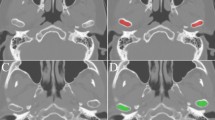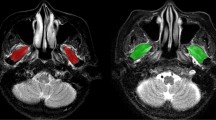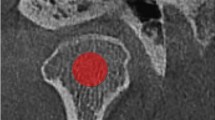Abstract
Objectives
Juvenile idiopathic arthritis (JIA) is a chronic inflammatory disease that affects the joints and other organs, including the development of the former in a growing child. This study aimed to evaluate the feasibility of texture analysis (TA) based on magnetic resonance imaging (MRI) to provide biomarkers that serve to identify patients likely to progress to temporomandibular joint damage by associating JIA with age, gender and disease onset age.
Methods
The radiological database was retrospectively reviewed. A total of 45 patients were first divided into control group (23) and JIA group (22). TA was performed using grey-level co-occurrence matrix (GLCM) parameters, in which 11 textural parameters were calculated using MaZda software. These 11 parameters were ranked based on the p value obtained with ANOVA and then correlated with age, gender and disease onset age.
Results
Significant differences in texture parameters of condyle were demonstrated between JIA group and control group (p < 0.05). There was a progressive loss of uniformity in the grayscale pixels of MRI with an increasing age in JIA group.
Conclusions
MRI TA of the condyle can make it possible to detect the alterations in bone marrow of patients with JIA and promising tool which may help the image analysis.

Similar content being viewed by others
Abbreviations
- JIA:
-
Juvenile idiopathic arthritis
- MRI:
-
Magnetic resonance imaging
- TA:
-
Texture analysis
- TMJ:
-
Temporomandibular joint
- ILAR:
-
International League of Associations for Rheumatology
- DICOM:
-
Digital Imaging and Communications in Medicine
- FOV:
-
Field of view
References
Ravelli A, Martini A. Juvenile idiopathic arthritis. Lancet. 2007;369(9563):767–78. https://doi.org/10.1016/S0140-6736(07)60363-8.
Navallas M, Inarejos EJ, Iglesias E, et al. MR imaging of the temporomandibular joint in juvenile idiopathic arthritis: technique and findings. Radiographics. 2017;37(2):595–612. https://doi.org/10.1148/rg.2017160078.
Tolend MA, Twilt M, Cron RQ, et al. Toward establishing a standardized magnetic resonance imaging scoring system for temporomandibular joints in juvenile idiopathic arthritis. Arthritis Care Res. 2018;70(5):758–67. https://doi.org/10.1002/acr.23340.
Hechler BL, Phero JA, Van Mater H, et al. Ultrasound versus magnetic resonance imaging of the temporomandibular joint in juvenile idiopathic arthritis: a systematic review. Int J Oral Maxillofac Surg. 2018;47(1):83–9. https://doi.org/10.1016/j.ijom.2017.07.014.
Stoll ML, Morlandt AB, Teerawattanapong S, et al. Safety and efficacy of intra-articular infliximab therapy for treatment-resistant temporomandibular joint arthritis in children: a retrospective study. Rheumatology. 2013;52(3):554–9. https://doi.org/10.1093/rheumatology/kes318.
Rongo R, Alstergren P, Ammendola L, et al. Temporomandibular joint damage in juvenile idiopathic arthritis: diagnostic validity of diagnostic criteria for temporomandibular disorders. J Oral Rehabil. 2019;46(5):450–9. https://doi.org/10.1111/joor.12769.
Stoustrup P, Lerman MA, Twilt M. The temporomandibular joint in juvenile idiopathic arthritis. Rheum Dis Clin North Am. 2021;47(4):607–17. https://doi.org/10.1016/j.rdc.2021.06.004.
Wang XD, Zhang JN, Gan YH, et al. Current understanding of pathogenesis and treatment of TMJ osteoarthritis. J Dent Res. 2015;94(5):666–73. https://doi.org/10.1177/0022034515574770.
Li G, Yin J, Gao J, et al. Subchondral bone in osteoarthritis: insight into risk factors and microstructural changes. Arthritis Res Ther. 2013;15(6):223. https://doi.org/10.1186/ar4405.
Tomas X, Pomes J, Berenguer J, et al. MR imaging of temporomandibular joint dysfunction: a pictorial review. Radiographics. 2006;26(3):765–81. https://doi.org/10.1148/rg.263055091.
de Albuquerque M, Anjos LG, de Andrade HMT, et al. MRI texture analysis reveals deep gray nuclei damage in amyotrophic lateral sclerosis. J Neuroimaging. 2016;26(2):201–6. https://doi.org/10.1111/jon.12262.
de Oliveira MS, Balthazar ML, D’Abreu A, et al. MR imaging texture analysis of the corpus callosum and thalamus in amnestic mild cognitive impairment and mild Alzheimer disease. AJNR Am J Neuroradiol. 2011;32(1):60–6. https://doi.org/10.3174/ajnr.A2232.
Goncalves BC, de Araujo EC, Nussi AD, et al. Texture analysis of cone-beam computed tomography images assists the detection of furcal lesion. J Periodontol. 2020. https://doi.org/10.1002/JPER.19-0477.
De Rosa CS, Bergamini ML, Palmieri M, et al. Differentiation of periapical granuloma from radicular cyst using cone beam computed tomography images texture analysis. Heliyon. 2020;6(10): e05194. https://doi.org/10.1016/j.heliyon.2020.e05194.
Hirvasniemi J, Gielis WP, Arbabi S, et al. Bone texture analysis for prediction of incident radiographic hip osteoarthritis using machine learning: data from the Cohort Hip and Cohort Knee (CHECK) study. Osteoarthritis Cartilage. 2019;27(6):906–14. https://doi.org/10.1016/j.joca.2019.02.796.
Mungai F, Verrone GB, Pietragalla M, et al. CT assessment of tumor heterogeneity and the potential for the prediction of human papillomavirus status in oropharyngeal squamous cell carcinoma. Radiol Med. 2019. https://doi.org/10.1007/s11547-019-01028-6.
Goh V, Ganeshan B, Nathan P, et al. Assessment of response to tyrosine kinase inhibitors in metastatic renal cell cancer: CT texture as a predictive biomarker. Radiology. 2011;261(1):165–71. https://doi.org/10.1148/radiol.11110264.
Doshi AM, Ream JM, Kierans AS, et al. Use of MRI in differentiation of papillary renal cell carcinoma subtypes: qualitative and quantitative analysis. AJR Am J Roentgenol. 2016;206(3):566–72. https://doi.org/10.2214/AJR.15.15004.
Ganeshan B, Miles KA. Quantifying tumour heterogeneity with CT. Cancer Imaging. 2013;26(13):140–9. https://doi.org/10.1102/1470-7330.2013.0015.
Calle AJM, Ogawa CM, Martins JS, et al. Temporomandibular joint in juvenile idiopathic arthritis: magnetic resonance imaging measurements and their correlation with imaging findings. Oral Radiol. 2021. https://doi.org/10.1007/s11282-021-00576-w.
Petty RE, Southwood TR, Baum J, et al. Revision of the proposed classification criteria for juvenile idiopathic arthritis: Durban, 1997. J Rheumatol. 1998;25(10):1991–4.
Costa ALF, de Souza CB, Fardim KAC, et al. Texture analysis of cone beam computed tomography images reveals dental implant stability. Int J Oral Maxillofac Surg. 2021;50(12):1609–16. https://doi.org/10.1016/j.ijom.2021.04.009.
Haralick RS, ShanmugamDinstein KIH. Textural Features for Image Classification. IEEE Trans Syst Man Cybern. 1973;3:610–21.
Collin M, Hagelberg S, Ernberg M, et al. Temporomandibular joint involvement in children with juvenile idiopathic arthritis-symptoms, clinical signs and radiographic findings. J Oral Rehabil. 2022;49(1):37–46. https://doi.org/10.1111/joor.13269.
Thierry S, Fautrel B, Lemelle I, et al. Prevalence and incidence of juvenile idiopathic arthritis: a systematic review. Joint Bone Spine. 2014;81(2):112–7. https://doi.org/10.1016/j.jbspin.2013.09.003.
Hemke R, Herregods N, Jaremko JL, et al. Imaging assessment of children presenting with suspected or known juvenile idiopathic arthritis: ESSR-ESPR points to consider. Eur Radiol. 2020;30(10):5237–49. https://doi.org/10.1007/s00330-020-06807-8.
Paniagua B, Ruellas AC, Benavides E, et al. Validation of CBCT for the computation of textural biomarkers. Proc SPIE Int Soc Opt Eng. 2015;17:9417. https://doi.org/10.1117/12.2081859.
Prothero J, Vimort JB, Ruellas A, et al. Advanced statistical analysis to classify high dimensionality textural probability-distribution matrices. Proc SPIE Int Soc Opt Eng. 2019. https://doi.org/10.1117/12.2507978.
Bianchi J, Goncalves JR, de Oliveira Ruellas AC, et al. Quantitative bone imaging biomarkers to diagnose temporomandibular joint osteoarthritis. Int J Oral Maxillofac Surg. 2021;50(2):227–35. https://doi.org/10.1016/j.ijom.2020.04.018.
Funding
This study was supported by FAPESP (São Paulo Research Foundation) Grants: 2017/09550-4, 2019/00495-6 and 20/08883-2.
Author information
Authors and Affiliations
Corresponding author
Ethics declarations
Conflict of interests
All authors of this work declare no conflict of interest.
Ethics approval
The study was approved by the Institutional Review Board of UNICAMP, according to Protocol Number 54900216.9.0000.5404. All procedures followed were in accordance with the ethical standards of the responsible committee on human experimentation (institutional and national) and with the Helsinki Declaration of 1975, as revised in 2008. Informed consent was obtained from all patients for being included in the study.
Informed consent
Written informed consent was obtained from the guardian of each participant, after informed about the study.
Additional information
Publisher's Note
Springer Nature remains neutral with regard to jurisdictional claims in published maps and institutional affiliations.
Rights and permissions
Springer Nature or its licensor holds exclusive rights to this article under a publishing agreement with the author(s) or other rightsholder(s); author self-archiving of the accepted manuscript version of this article is solely governed by the terms of such publishing agreement and applicable law.
About this article
Cite this article
Ricardo, A.L.F., da Silva, G.A., Ogawa, C.M. et al. Magnetic resonance imaging texture analysis for quantitative evaluation of the mandibular condyle in juvenile idiopathic arthritis. Oral Radiol 39, 329–340 (2023). https://doi.org/10.1007/s11282-022-00641-y
Received:
Accepted:
Published:
Issue Date:
DOI: https://doi.org/10.1007/s11282-022-00641-y




